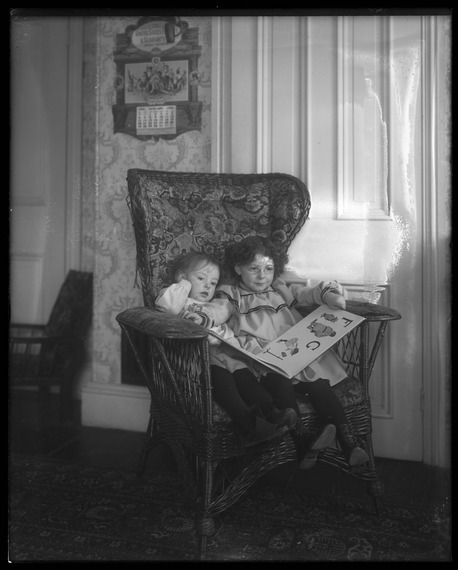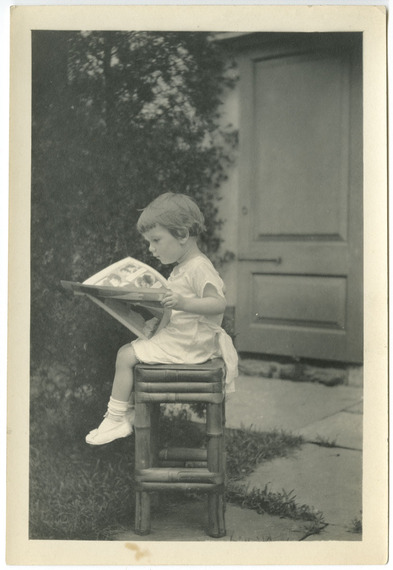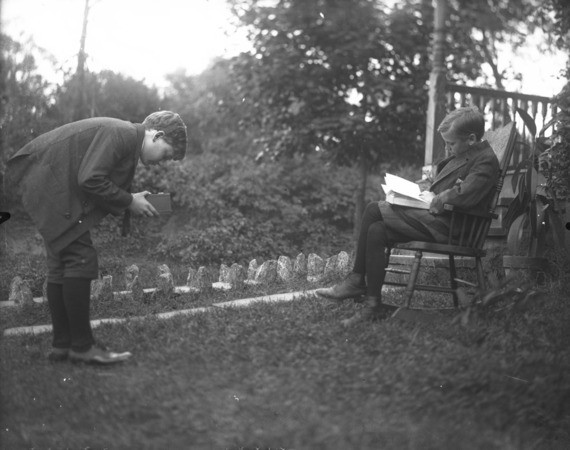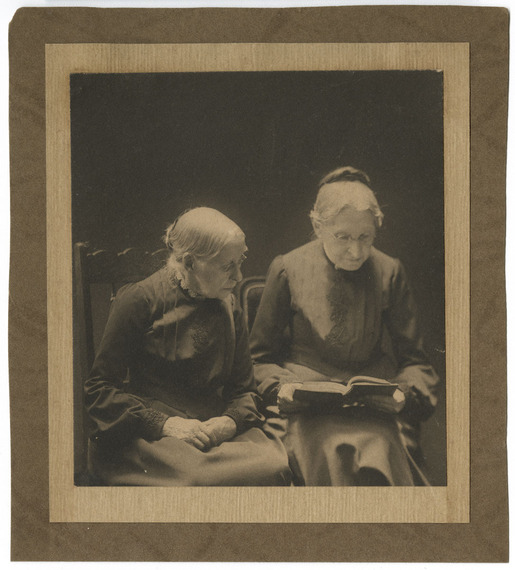The Library Company recently designed and began selling a T-shirt with a quote from Benjamin Franklin's sister Jane Franklin. "I read as much as I dare," she declared in a letter to her brother. With Jane's words as inspiration I began looking through our collection for photographic portraits of people with books or other reading material.
Books appear as studio props with relative frequency even in some of our earliest photographs. Sitters may have felt that being portrayed next to books stacked on a table or posing with a book in one's lap lent an air of education or sophistication to a portrait. In her portrait, Juliana Randolph Wood, a member of a prominent Philadelphia Quaker family, pays little heed to the daguerreotypist taking her image. Her attention is completely occupied with the book opened on the table next to her.

Montgomery P. Simons, Julianna Randolph Wood, ca. 1847. P.8928.2. Gift of Radclyffe F. & Maria M. Thompson.
Providing children with a book or a toy to ensure cooperation in the tedious process of sitting for a portrait has long been a staple in the portrait photographer's arsenal. Although the child on the left seems a tad bored with the letters "F" and "G" in the image below, both children in this turn-of-the century image sit quietly with the large book opened on their laps.

Seth Pancoast Levis, Children Reading, 1909. P.9645.372. Gift of Matthew Schultz.
The latest in women's hairstyles seems to have completely captivated the attention of the little girl who posed with her magazine and perfect posture for a series of portraits by the well-known Philadelphia female artist Jessie Willcox Smith.

Jessie Willcox Smith, Unidentified Girl Reading, ca. 1920. P.9446.
Even an amateur photographer knew that having a relaxed sitter engaged in reading made the work of the photographer go the most smoothly. Here a boy looks down at a book while his brother or friend attempts to take his portrait.

Frank Berry, Boy Photographing Another Young Boy, ca. 1907. P.8986.40. Gift of Richard R. Frame.
For elderly sitters, a book may have represented the knowledge and wisdom acquired over a long life. In this photographic portrait, later given to a family member, the two older women, identified as sisters in their 80s, share a book.

Ludecke Studio, Cousin Matttie Wright's Aunts from Wilmington, 1912.
In the earliest days of photography, books provided a familiar and comfortable prop during what might have been a person's first experience of sitting for a daguerreotype. Even as photography grew commonplace, reading material gave sitters something to focus on to alleviate the self-consciousness that often accompanies sitting for a portrait session. Whether young or old, sitters with a book could at least give the illusion of being caught in a moment of quiet reflection.
Support HuffPost
Our 2024 Coverage Needs You
Your Loyalty Means The World To Us
At HuffPost, we believe that everyone needs high-quality journalism, but we understand that not everyone can afford to pay for expensive news subscriptions. That is why we are committed to providing deeply reported, carefully fact-checked news that is freely accessible to everyone.
Whether you come to HuffPost for updates on the 2024 presidential race, hard-hitting investigations into critical issues facing our country today, or trending stories that make you laugh, we appreciate you. The truth is, news costs money to produce, and we are proud that we have never put our stories behind an expensive paywall.
Would you join us to help keep our stories free for all? Your contribution of as little as $2 will go a long way.
Can't afford to donate? Support HuffPost by creating a free account and log in while you read.
As Americans head to the polls in 2024, the very future of our country is at stake. At HuffPost, we believe that a free press is critical to creating well-informed voters. That's why our journalism is free for everyone, even though other newsrooms retreat behind expensive paywalls.
Our journalists will continue to cover the twists and turns during this historic presidential election. With your help, we'll bring you hard-hitting investigations, well-researched analysis and timely takes you can't find elsewhere. Reporting in this current political climate is a responsibility we do not take lightly, and we thank you for your support.
Contribute as little as $2 to keep our news free for all.
Can't afford to donate? Support HuffPost by creating a free account and log in while you read.
Dear HuffPost Reader
Thank you for your past contribution to HuffPost. We are sincerely grateful for readers like you who help us ensure that we can keep our journalism free for everyone.
The stakes are high this year, and our 2024 coverage could use continued support. Would you consider becoming a regular HuffPost contributor?
Dear HuffPost Reader
Thank you for your past contribution to HuffPost. We are sincerely grateful for readers like you who help us ensure that we can keep our journalism free for everyone.
The stakes are high this year, and our 2024 coverage could use continued support. If circumstances have changed since you last contributed, we hope you’ll consider contributing to HuffPost once more.
Already contributed? Log in to hide these messages.




